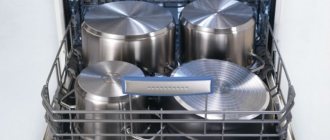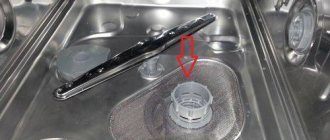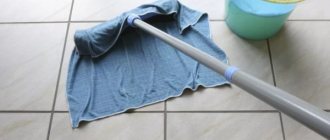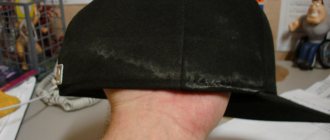How to use a dishwasher
The dishwasher can be used to wash a variety of dishes, from wine glasses to baking trays. Much depends on the right program. But not all materials benefit from prolonged exposure to water and high temperatures.
Chemical detergents and hot air drying should also be considered.
Recommendations for use
To ensure that the dishes are washed well and that kitchen items are not damaged, you should follow several recommendations:
- Crystal dishes are resistant to high temperatures, but are afraid of sudden changes;
- heat-resistant plastic can be washed without placing it in the lower basket;
- ceramic dishes can be washed without restrictions;
- aluminum products may become covered with a gray coating after washing and drying;
- For porcelain, only delicate mode is acceptable, otherwise it may crack and fade;
- Cast iron items may become rusty.
Dishwasher.
Place dishes correctly inside the machine
Proper loading of the dishwasher determines the quality of the wash. If you do not follow the following tips, you will not be happy with the results:
Upper basket
Cups, plates, glasses and various small items are placed in it. Some models allow you to choose the optimal height for uniform wetting of loaded items.
Lower basket
It is designed to accommodate frying pans, pots, baking sheets, large plates and large items. On many models, the holders can be folded out to distribute dishes evenly.
Tray
This is a small removable basket in which to place forks, spoons and knives. More expensive models of machines are equipped with a tray for silver items.
Choose the right washing mode
After all the dishes have been placed and the detergent has been added, you should select the correct washing mode. Almost all dishwashers have the following types of programs:
- Economical washing . This mode implies minimal consumption of electricity and water.
- Standard mode. The process takes from 1 to 1.5 hours. This mode is used to wash dishes that are normally soiled.
- Intensive washing . In this case, we mean washing heavily soiled dishes. The temperature is maintained within 65-70 degrees. The process includes preliminary and main washing.
- Soaking . In this mode, pans or baking sheets with burnt marks or congealed fat are washed.
- Delicate . The washing temperature is maintained at 40-45 degrees. This mode is designed for crystal, glass or porcelain.
- Quick wash . With this program, the cycle is much shorter, the temperature does not exceed 55 degrees. Suitable for light stains.
- Automatic . The most optimal option for varying degrees of soiling of dishes. The number of devices does not matter and the optimal temperature regime is set.
Select the required mode.
Hardness of water
It is necessary to monitor this water indicator. This is necessary to ensure that the dishwasher regulator dials in the required amount of salt. There is a special sensor that will show when the salt runs out. In this case, it must be added.
Dishwasher Care
For proper and long-term service of the dishwasher, the following tips must be followed:
- after work, wipe all the walls of the chamber with a dry sponge;
- Clean the dishwasher once a quarter;
- after the washing procedure, you should take out the mesh filter and clean it of any remaining waste;
- To completely dry the camera after use, leave the door ajar to prevent an unpleasant odor;
- Use anti-scale and anti-grease products to clean sink elements.
Dishwasher care.
Can knives be washed in the dishwasher?
According to some experts, knives can become dull in a washing machine. This is facilitated by the strong water pressure in the device. The opinion is quite controversial and strange. But what some manufacturers indicate whether an item can be washed in a machine is true.
To prevent the life of the knife and its premature frenzy, it is better to wash it by hand. In some cases, the blade can damage the washer blades. Let's take a closer look at the reasons why it is not recommended to wash knives in the dishwasher.
Knife handle
Knife handles made from natural materials, such as wood, will become unusable after a few washes. The effects of high temperature and detergents will affect this. Handles may swell and crack. The same applies to low quality plastic products.
Wooden knife handles.
Stainless steel
Completely stainless steels do not exist in nature; it is just a matter of time. Some grades of steel rust faster, others slower. You should also consider the exposure of the blade to water for an hour or more. Presence of detergents. All this can lead to the appearance of pitting corrosion.
Ceramic knives
According to experts, the processes occurring inside the dishwasher greatly affect ceramic knives. After 5-7 washes, the products stop showing their excellent cut. Washing ceramic knives has a significant impact on their cutting edges.
Ceramic knives.
Steel hardness
The heat treatment of steel should be taken into account when making knives; it includes several stages. One of them includes long-term tempering of steel at a temperature of 200 degrees. The temperature in the dishwasher can reach 70-80 degrees. But with prolonged influence on the blade, its hardness may decrease.
Cutting edge
If you are very picky about your knife cuts and know how to properly sharpen your kitchen knives, you may notice some changes. The action of high temperatures and water pressure can definitely lead to slight deformation of the cutting edge.
Cutting edges under a microscope.
Reasons for damage to metal knives
Most housewives use kitchen knives whose blades are made of steel. How can a dishwasher such a cooking tool?
Strong pressure and high water temperature
Another reason why the blade quickly becomes dull due to washing in the dishwasher is the very saturated water pressure in the chamber. And although, according to the instructions, in most cases it is not prohibited to wash devices with blades in the dishwasher, it is better to avoid this. This way the service life will be significantly longer.
The thin blade of a kitchen knife can become deformed when exposed to hot water. Metal is rapidly becoming unusable.
- wood ones swell from water at high temperatures, and then burst when dry;
- plastic ones can crack over time.
It’s especially a pity to damage expensive professional appliances in the dishwasher.
How to properly clean knives
To extend the life of the knife, it should be properly cleaned. The following tips will help you do this:
- Cleaning with a mild detergent is done using a sponge and soap solution. Then you should wash off the dirt;
- Wiping is necessary after using the knife. This removes food residues. Then everything is washed off with a napkin or sponge in running water;
- If food residues have dried to the blade, it should be soaked for 2-3 minutes. Then rinse everything off with running water;
- After washing, the product must be wiped with a clean towel.
Do you have a dishwasher?
Of course! Not yet...
Storage and care
Knives require careful handling, so they will serve their owner for a long time and faithfully. Store and care for blades as follows:
- Not only the blade, but also the handle requires care;
- use knives only for their intended purpose;
- sharpen the product on time;
- blades should be stored separately from other cutlery;
- Scratches may appear on silverware;
- store knives in special stands or cases;
- when working the product, use a wooden or plastic board;
- sharpen on an abrasive stone with soapy water;
- products with wooden, leather or bone handles are prohibited from being washed in the dishwasher;
- metal, glass and stone boards spoil the cutting edge of the blade;
- hunting and tourist products are stored in a case away from moisture;
- handles made of bone or horn do not like temperature changes;
- during long-term storage, the blade is lubricated with wax or oil.
Tips for proper care
To ensure that your knives last a long time, you should keep in mind the following rules for use and care:
- Use a separate device for each purpose. A knife for cutting meat fillets can be damaged by cutting bones. And a butter knife will be forever ruined by cutting fish.
- The knife must be stored in a drawer, wrapped in paper or cardboard. This way it will absorb excess water and the blade will not be damaged by other devices.
- It is better to use wood and plastic cutting boards. Boards made of ceramics, glass, and marble wear out very quickly and damage the blade. The best option is thickened paper or soft cardboard.
- It's easy and convenient to store sharp utensils on a magnetic holder that can be installed directly on the kitchen wall.
READ What is the power of an electric kettle in kW
So, it is better not to wash either expensive professional knives or cheap Chinese knives in the dishwasher. The brutal environment in the car will quickly ruin any blade or handle. It’s easier, safer and faster to simply rinse the knife, wipe it with a dry cloth and put it away until further use.
Manual knife washing
You don't necessarily need a dishwasher to clean your knife. This can be done manually using the following tips:
- try not to leave the blade stained with food for a long time. Then it will be enough to rinse it in water and wipe with a towel;
- If you cannot immediately remove food residues, then soak the blade for a couple of minutes in water with detergent. Then remove the dirt;
- keep knives away from damp places, this will prevent pitting corrosion;
- All blades require maintenance, even if they are used once a month.
Can ceramic blades be washed in the dishwasher?
There are several reasons for refusing to machine wash metal blades. But what about ceramic ones? They are less whimsical, but also less wear-resistant. If you use a ceramic blade continuously, it will become dull in less than a year. And after two, you can already throw it away, since it is almost impossible to sharpen it.
Do not reduce the sharpness of the cutting edge by washing it in the dishwasher. It is enough to simply wash it by wiping it with a damp cloth and then with a dry towel.
You cannot keep a ceramic blade dirty for long. It may lose color, especially if it is light-colored. Also, the blade can be stained by the juices of vegetables and fruits, which makes it difficult to wash.











